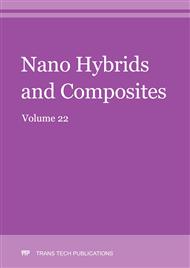[1]
J. Liou, C.Yang, Design and fabrication of micro-LED array with applicationspecific integrated circuits (ASICs) light emitting display, Microsyst Technol, (2017).
DOI: 10.1007/s00542-017-3640-1
Google Scholar
[2]
K. R. Son, B. R. Lee, T. G. Kim, Improved optical and electrical properties of GaN-based micro light-emitting diode arrays, Current Applied Physics xxx, (2017), 1-6.
DOI: 10.1016/j.cap.2017.11.013
Google Scholar
[3]
G. L. Ingram, Y. Zhao and Z. Lu, Exciton dynamics of luminescent defects in aging organic light-emitting diodes, Journal of Applied Physics, 122, (2017), 245501.
DOI: 10.1063/1.5003011
Google Scholar
[4]
H. Z. Siboni, B. Sadeghimakki, S. Sivoththaman and H. Aziz, Very high brightness quantum dot light-emitting devices via enhanced energy transfer from a phosphorescent sensitizer, ACS Appl. Mater. Interfaces, 7, (2015), 25828−25834.
DOI: 10.1021/acsami.5b08097
Google Scholar
[5]
S. M. Menke, R. H. Friend and D. Credgington, Polymer light emitting diode, Chapter 7, University of Cambridge, UK, (2016).
Google Scholar
[6]
S. Coe-Sullivan, W. Woo, J. S. Steckel , M. Bawendi, V. Bulovic, Tuning the performance of hybrid organic/inorganic quantum dot light-emitting devices, Organic Electronics, 4, (2003), 123–130.
DOI: 10.1016/j.orgel.2003.08.016
Google Scholar
[7]
Z. Lingley, S. Lu and A. Madhukar, The dynamics of energy and charge transfer in lead sulfide quantum dot solids, Journal of Applied Physics, 115, (2014), 084302.
DOI: 10.1063/1.4866368
Google Scholar
[8]
D. Di, A. S. Romanov, L. Yang, J. M. Richter, J. P. H. Rivett, S. Jones, T. H. Thomas, M. Abdi-Jalebi, R. H. Friend, M. Linnolahti, M. Bochmann, D. Credgington, High-performance light-emitting diodes based on carbene-metal-amides, Science, (2017).
DOI: 10.1126/science.aah4345
Google Scholar
[9]
H. Xue , R. Wu , Y. Xie , Q. Tan , D. Qin, H. Wu and W. Huang, Recent progress on solution-processed CdTe nanocrystals solar cells, Appl. Sci., 6, (2016), 197.
DOI: 10.3390/app6070197
Google Scholar
[10]
N. McElroy, R. C. Page, D. Espinbarro-Valazquez E. Lewis, S. Haigh, P. O. Brien, D. J. Binks, Comparison of solar cells sensitised by CdTe/CdSe and CdSe/CdTe core/shell colloidal quantum dots with and without a CdS outer layer, Thin Solid Film, 560, (2014).
DOI: 10.1016/j.tsf.2013.10.085
Google Scholar
[11]
T. Ding, X. Yang, L. Ke, Y. Liu, W. Tan, N. Wang, X. Zhu, X. W. Sun, Improved quantum dot light-emitting diodes with a cathode interfacial layer, Organic Electronics, 32, (2016), 89-93.
DOI: 10.1016/j.orgel.2016.02.018
Google Scholar
[12]
D. Liang, Y. Peng, Y. Fu, M. J. Shearer, J. Zhang, J. Zhai, Y. Zhang, R. J. Hamers, T. L. Andrew and S. Jin, Color-pure violet-light-emitting diodes based on layered lead halide perovskite nanoplates, ACS Nano, 10, (2016), 6897−6904.
DOI: 10.1021/acsnano.6b02683
Google Scholar
[13]
S. M. Sze and K. K. Ng, Physics of Semiconductor Devices, third ed., John Wiley and Sons, New York, (2007).
Google Scholar
[14]
Za'aba et al., Electronic device characteristics and charge conduction mechanisms of single-layer organic light emitting devices based on Alq3, TPD:Alq3 and TPD:PBD:Alq3 blend system, Journal of Nanoelectronics and Optoelectronics, 8, (2013).
DOI: 10.1166/jnn.2009.1774
Google Scholar
[15]
T. Chiba, Y. J. Pu, H. Sasabe, J. Kido, Y. Yang, Solution-processed organic light-emitting devices with two polymer light-emitting units connected in series by a charge-generation layer, Journal of Materials Chemistry, (2012), 1-5.
DOI: 10.1039/c2jm35344j
Google Scholar
[16]
J. Schanda, Colorimetry: Understanding the CIE system, first ed., John Wiley, (2008).
Google Scholar
[17]
C. Li, G. Cui, M. Melgosa, X. Ruan, Y. Zhang, L. Ma, K. Xiao and M. R. Luo, Correlated color temperature as an explicit function of chromaticity coordinates, Optical Society of America (Optics Express), 24, (2016), 13.
DOI: 10.1364/oe.24.014066
Google Scholar
[18]
S. V. Boriskina, H. Ghasemi, G. Chen, Plasmonic materials for energy: from physics to applications, Materials Today, 16, 2013, 375-386.
DOI: 10.1016/j.mattod.2013.09.003
Google Scholar
[19]
A. M. Kadim, Fabrication of quantum dots light emitting device by using CdTe quantum dots and organic polymer, Journal of Nano Research, 50, 2017, 48-56.
DOI: 10.4028/www.scientific.net/jnanor.50.48
Google Scholar
[20]
A. M. Kadim, Zinc selenide quantum dots light emitting devices (ZnSe QDs-LEDs) with different organic polymers, Nano Hybrids and Composites, 18, 2017, 11-19.
DOI: 10.4028/www.scientific.net/nhc.18.11
Google Scholar
[21]
A. M. Kadim, O. A. Ibrahim and W. R. Saleh, Electroluminescence devices from quantum dots with TPD polymer white light generation, Journal of Nano Research, 48, 2017, 104-113.
DOI: 10.4028/www.scientific.net/jnanor.48.104
Google Scholar


